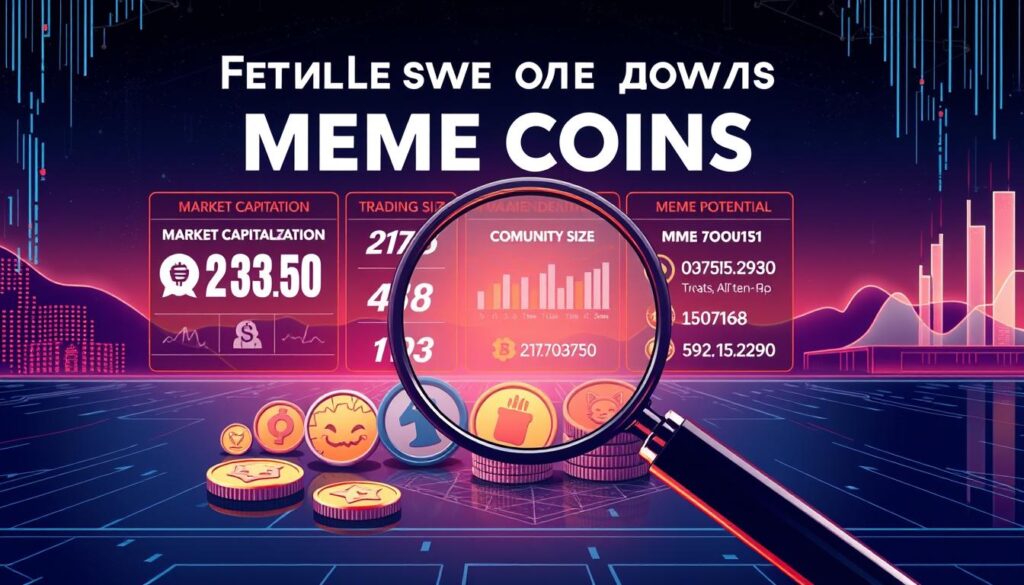Now Reading: Top Meme Coins with 100x Potential: A Comprehensive List
- 01
Top Meme Coins with 100x Potential: A Comprehensive List
Top Meme Coins with 100x Potential: A Comprehensive List

The digital asset landscape is buzzing with excitement. While Bitcoin trades above $118,000 and institutional money flows in, a unique corner of the crypto market is capturing imaginations. This guide explores the fascinating world of meme-inspired digital assets.
These tokens blend internet culture with financial speculation, creating unprecedented opportunities. They also carry significant risks due to their extreme volatility. Understanding the current market dynamics is crucial for any investor.
We will examine various categories of promising digital assets. From established names like Dogecoin to new presale projects, this list highlights options with substantial growth potential. The goal is to balance entertainment value with real utility.
This article provides actionable insights into what separates successful projects from failures. You will learn about market cap dynamics, tokenomics, and staking rewards. Our aim is to help you navigate this complex but exciting segment of the crypto universe.
Key Takeaways
- Meme coins represent a high-risk, high-reward segment of the cryptocurrency market.
- Current favorable market conditions can fuel significant growth for low-capitalization assets.
- A successful project often balances cultural relevance with tangible utility.
- Understanding tokenomics and market capitalization is essential for evaluation.
- Early-stage investments require careful research due to inherent volatility.
- This guide covers a range of tokens, from well-known to emerging presales.
Introduction to Meme Coins and 100x Investment Potential
Institutional capital is flowing into cryptocurrency products at record-breaking rates. Weekly inflows exceeding $4.39 billion demonstrate growing confidence in digital assets. This creates a favorable environment for various investment opportunities.
Setting the Stage in Today’s Crypto Market
Bitcoin maintains strong momentum above $118,000 through September 2025. Established digital assets reaching new highs often create space for smaller projects. The current crypto landscape presents unique timing advantages.
The meme sector experienced significant valuation adjustments recently. Total market capitalization dropped from above $80 billion to below $67 billion. This pullback represents strategic entry points for knowledgeable participants.
Why 100x Potential Attracts Investors
Many investors seek exponential growth that traditional assets cannot easily provide. Diminishing returns from major cryptocurrencies push capital toward higher-risk opportunities. The appeal lies in balancing calculated risk with substantial reward potential.
Early positioning during presale stages can lead to significant returns. Projects gaining traction on exchanges and social media often experience rapid appreciation. Understanding market cycles helps investors identify optimal entry points.
For those seeking early-stage opportunities, current conditions offer compelling options. The combination of viral community engagement and low initial valuations creates unique dynamics.
| Investment Type | Risk Level | Growth Potential | Market Timing |
|---|---|---|---|
| Established Cryptocurrencies | Moderate | Steady | Consistent |
| Emerging Digital Assets | High | Exponential | Cyclical |
| Presale Opportunities | Very High | Maximum | Strategic |
| Traditional Investments | Low | Limited | Long-term |
Understanding the Crypto Market and Market Cap Dynamics
A coin’s price tag often tells an incomplete story without considering its total market value. The market cap provides this crucial context. It is calculated by multiplying the current price by the total number of coins in circulation.
This metric reveals the true size and scale of a project within the broader crypto market.
Market Trends and Current Data Insights
Recent market shifts are creating unique opportunities. Bitcoin’s dominance has declined to around 56%. This often signals the start of an “altcoin season,” where capital flows into smaller projects.
This environment is particularly favorable for low-cap cryptocurrencies. These are typically projects valued under $100 million. They possess a higher growth potential compared to giants with multi-billion dollar valuations.
However, nearly half of all projects launched since 2021 have failed. This highlights the significant risks involved.
How Market Cap Influences Investment Decisions
Smart investors use market cap to gauge realistic growth. A project with a $10 million cap reaching $1 billion is a 100x gain. This is far more feasible than a $50 billion project aiming for $5 trillion.
Trading volume is another key factor. Healthy projects often see daily volume between 5-20% of their market cap. This indicates strong liquidity and investor interest.
| Market Cap Tier | Typical Valuation | Risk Profile | Realistic Growth Ceiling |
|---|---|---|---|
| Micro-Cap | Under $50 million | Very High | Exponential (100x+) |
| Low-Cap | $50M – $300M | High | Significant (10x-50x) |
| Mid-Cap | $300M – $2B | Moderate to High | Substantial (5x-20x) |
| Large-Cap | Over $2 Billion | Moderate | Steady (2x-5x) |
Defining Meme Coins and Their Unique Appeal
The fusion of humor and finance has created a powerful force within the cryptocurrency ecosystem. These digital assets are inspired by internet culture, viral content, and shared jokes.
They often start as lighthearted projects but can evolve into serious ventures.
Their unique charm lies in blending entertainment with financial speculation. This combination fosters incredibly engaged communities.
Members actively promote their favorite projects across social media. This creates a self-sustaining cycle of attention and growth.
The Rise of Internet Culture in Crypto
Unlike traditional crypto projects focused on tech, these coins leverage community-driven hype. They tap into viral marketing dynamics where users become promoters.
This organic growth can rapidly increase a project’s visibility. It also democratizes investment, letting people back ideas they connect with.
The psychological appeal is strong. Low entry prices, the thrill of a movement, and a shared experiment are key drivers.
Early projects were purely jokes. Now, many new coins incorporate real utility and staking features. This blends fun with genuine crypto functionality.
Exploring Top Meme Coins with 100x Potential
Successful investors employ specific metrics to distinguish promising opportunities from speculative gambles. This systematic approach helps identify assets with genuine growth prospects.

A thorough evaluation framework examines multiple interconnected factors. These criteria provide a comprehensive view of each project’s viability.
Key Criteria for Evaluating Meme Coins
Market capitalization serves as a fundamental starting point. Projects with lower valuations have clearer pathways to significant appreciation.
The entry price and total supply directly impact future growth. Excessive token creation can dilute value regardless of demand.
Community engagement indicates genuine interest versus artificial hype. Active social media presence and organic content creation signal strong foundation.
Development team transparency and roadmap clarity reduce investment risk. Regular updates and audited contracts demonstrate professional commitment.
| Evaluation Factor | Importance Level | Key Metrics | Risk Consideration |
|---|---|---|---|
| Market Capitalization | Critical | Under $20M ideal | Higher cap = lower growth potential |
| Token Supply & Distribution | High | Limited, fair allocation | Unlimited minting = value dilution |
| Community Strength | High | Organic engagement rates | Artificial hype = quick collapse |
| Team Transparency | Medium-High | Doxxed, active developers | Anonymous teams = higher risk |
| Utility & Roadmap | Medium | Clear use cases, timeline | Pure speculation = limited longevity |
These evaluation criteria help investors make informed decisions. Proper assessment separates sustainable projects from fleeting trends.
Detailed Analysis of Promising Meme Coin Projects
The presale landscape offers unique entry points for strategic investors seeking growth. Several innovative projects are demonstrating impressive fundraising results and community support.
Overview of Early-Stage and Low-Cap Coins
BullZilla leads with over $1 million raised and exceptional ROI projections. The coin shows strong momentum with 3,500+ holders already participating.
Bitcoin Hyper distinguishes itself as a Layer-2 solution with nearly $19 million raised. It offers substantial staking rewards up to 60% APY for early participants.
Pepenode introduces a gamified “mine-to-earn” model at an attractive entry price. Snorter Token combines utility with meme appeal as a Telegram trading bot.
Insights from Commercial Partners and Analysts
Low market cap projects under $100 million represent optimal growth opportunities. Their smaller valuation allows for exponential appreciation when gaining traction.
Analysts emphasize entering during presale stages when prices remain favorable. This timing maximizes returns before exchange listings drive mainstream attention.
Platform features like audited contracts and transparent tokenomics separate legitimate projects from risky ventures. These early-stage opportunities require careful evaluation but offer substantial potential.
Comparative Insights: Meme Coins vs. Established Cryptocurrencies
Portfolio construction in the cryptocurrency space requires understanding different asset classes and their growth profiles. The current market presents distinct opportunities across various digital assets.

Comparisons with Bitcoin, Ethereum, and Others
Established cryptocurrencies like Bitcoin have reached maturity levels where exponential returns become mathematically challenging. For Bitcoin to achieve 100x growth from its current $118,000 position, it would need a market capitalization exceeding global economic output.
These blue-chip assets operate in a fundamentally different risk category compared to emerging alternatives. While Bitcoin trading above $118,000 shows market strength, its 56% dominance indicates capital flowing toward smaller projects.
Ethereum and other layer-1 blockchains provide infrastructure stability that benefits newer coins built on their networks. This creates an interesting dynamic where established platforms support innovative projects.
Diversification strategies often combine stable holdings in major cryptocurrencies with calculated allocations to higher-risk opportunities. This approach balances portfolio security with growth potential.
Established coins offer predictable liquidity and regulatory clarity, while newer assets provide community-driven innovation. The key distinction lies in investment objectives and risk tolerance levels.
Assets like Bitcoin serve as market indicators—strong performance typically signals favorable conditions for the entire crypto ecosystem. This includes more speculative segments where rapid growth remains possible.
Investment Considerations: Risks, Staking, and Tokenomics
Investment decisions in this sector must balance the allure of high returns against significant volatility challenges. Nearly half of all projects launched since 2021 have failed completely, highlighting the importance of thorough evaluation.
Understanding Extreme Volatility and Liquidity Issues
Price swings of 50-200% can occur within single trading sessions. This extreme volatility stems from low trading volumes and rapid social media sentiment shifts.
Liquidity constraints present additional challenges. Small order sizes can dramatically impact prices, potentially trapping participants during market downturns. Proper risk management requires never investing more than one can afford to lose entirely.
Staking Rewards, Token Burn Mechanisms, and Utility
Staking systems offer compelling incentives for long-term holding. Projects like MoonBull provide 95% APY, while Bitcoin Hyper delivers 60% rewards to early participants.
Burn mechanisms like BullZilla’s HODL Furnace systematically reduce circulating supply. This creates deflationary pressure that supports price appreciation as demand increases.
Evaluating token distribution fairness is crucial. Balanced allocations with locked liquidity protect investors from sudden sell pressure. Sustainable projects demonstrate real utility beyond pure speculation.
Innovative Projects Driving 100x Potential Growth
Innovative blockchain projects are rewriting the rulebook for exponential growth through structured tokenomics. These ventures combine technical sophistication with community-driven mechanics.
They create sustainable frameworks that extend beyond typical speculative patterns. The most promising initiatives balance viral appeal with substantive development roadmaps.

Early Presales and Structured Tokenomics
BullZilla demonstrates advanced economic engineering with its Progressive Price Engine. This system methodically increases token value during presale phases.
The accompanying HODL Furnace mechanism creates deflationary pressure. This combination supports long-term price appreciation for sustainable growth.
MoonBull employs a 23-stage scarcity model with AI-powered staking optimization. This approach ensures predictable price progression while managing supply dynamics effectively.
Technical innovation distinguishes leading projects in this space. Bitcoin Hyper functions as a Layer-2 solution integrating Solana’s virtual machine with Bitcoin’s security.
Pepenode introduces a gamified “mine-to-earn” system that actively engages users. These projects demonstrate how structured approaches maximize investment potential.
Fair distribution strategies reveal project legitimacy. La Culex allocates 45% of its 200 billion token supply to presale participants while locking liquidity for stability.
User Rewards and Community-Driven Incentives
Effective reward systems create powerful incentives that transform casual participants into dedicated community members. These mechanisms turn passive holders into active promoters who drive organic growth.
Projects employ diverse approaches to distribute rewards. MoonBull offers 95% APY staking with AI optimization. La Culex provides 80% APY through its Hive Vault system.
Reward Structures, APYs, and Tokenomics Models
High yield offerings require careful evaluation. Sustainable rewards come from transaction fees or ecosystem revenue. Inflation-based systems can dilute long-term value.
Community incentives create self-reinforcing cycles. Referral programs like Bite Chain reward users for expanding networks. Bonus structures encourage ongoing participation.
Tokenomics must balance rewards with supply management. Strategic burns offset staking emissions. This prevents inflation while maintaining attractive yields for committed holders.
| Project | Reward Type | APY/Return | Sustainability Factor |
|---|---|---|---|
| MoonBull | Staking + AI Optimization | 95% APY | Fee-based revenue model |
| La Culex | Hive Vault + Referrals | 80% APY | Bite Chain community building |
| Apeing | Bonuses + Scheduled Burns | Variable | Deflationary tokenomics |
| BullZilla | Community Staking | Competitive | Progressive price engine |
The entire ecosystem benefits when users receive meaningful rewards. This alignment creates lasting value for all participants in successful digital asset projects.
The Role of Exchanges and Trading Platforms in Meme Coin Markets
The accessibility provided by trading platforms fundamentally transforms how new digital assets reach mainstream adoption. These venues serve as critical infrastructure that bridges community projects with global participants.

Exchange listings represent pivotal moments for emerging projects. BullZilla plans its debut at $0.00527, while Snorter Token targets $0.10 on decentralized exchanges. Major platform listings typically trigger significant price movements.
How Trading Volume Influences Potential Returns
Trading volume directly impacts investment outcomes through liquidity and price discovery. Higher volume reduces slippage and indicates genuine market interest.
Platform selection shapes investor demographics and trading patterns. Ethereum-based exchanges attract different users than Solana or Binance Smart Chain venues. This affects community composition and price stability.
Strategic listing approaches vary between immediate DEX launches and coordinated centralized exchange entries. Multi-platform strategies provide broader access and reduce single-point dependencies.
The relationship between exchanges and digital assets remains symbiotic. Platforms benefit from popular listings that drive fees, while projects gain legitimacy and market reach. This dynamic creates opportunities for careful investors.
Assessing Real-World Utility and Adoption in Meme Coins
Projects demonstrating tangible utility distinguish themselves from purely speculative ventures. Real-world applications transform digital assets into functional tools.
This evolution marks a significant shift in the crypto landscape. Sustainable projects solve actual problems rather than relying on temporary hype.
Blockchain Innovations and Use Case Developments
Infrastructure projects like Celer Network provide Layer-2 scaling across 40+ blockchain platforms. This addresses fundamental technical challenges.
Consumer-facing applications show remarkable progress. DIMO enables vehicle owners to monetize driving data through blockchain technology.
Hivemapper’s decentralized mapping network demonstrates practical utility. The platform forecasts exceeding $100 million in revenue by 2025.
Integration with Emerging Technologies
Artificial intelligence integration represents a major development frontier. Phala Network offers confidential computing for AI applications.
Real-world asset tokenization gains momentum through platforms like Propy. They’ve processed over $4 billion in property transactions.
Cross-chain interoperability solutions enable seamless ecosystem connectivity. This removes barriers for mainstream adoption.
Conclusion
Strategic positioning in emerging digital markets requires both technical understanding and market timing awareness. The current environment offers unique conditions for growth-oriented digital assets.
Successful participants recognize that thorough research separates sustainable ventures from fleeting trends. They evaluate tokenomics, community strength, and development roadmaps carefully.
The evolution toward utility-driven projects represents significant sector maturation. Many now integrate advanced features beyond pure speculation.
Investors must acknowledge the inherent volatility while pursuing asymmetric return profiles. Disciplined risk management remains essential for long-term success in this dynamic space.
FAQ
What exactly is a meme coin?
A meme coin is a type of cryptocurrency that originates from internet culture or a viral joke. Unlike Bitcoin or Ethereum, which are built on complex technology, these digital assets often gain value primarily from online community support and social media hype.
How can a meme coin achieve 100x growth?
Achieving such high returns typically involves a combination of factors. A low initial market cap, a strong and active community, strategic listings on major exchanges like Binance or Coinbase, and the development of real utility beyond the hype can all contribute to explosive price appreciation.
What are the biggest risks of investing in these cryptocurrencies?
The primary risks include extreme price volatility and low liquidity. Many meme coin projects lack the robust infrastructure and security of established blockchain networks, making them highly speculative assets where investors could lose their entire investment.
How does staking work with meme coins?
Some projects offer staking, allowing holders to lock up their tokens in a smart contract to support the network’s operations. In return, participants often earn rewards or a share of transaction fees, which can provide a passive income stream and help reduce token supply.
Why is market cap important when evaluating these projects?
Market capitalization (market cap) is a key metric because it shows the total value of all coins in circulation. A lower market cap suggests more room for growth, meaning a project has a higher potential for significant returns compared to a coin with a multi-billion dollar valuation.
Do meme coins have any real-world utility?
While many start as jokes, some evolve to offer genuine utility. This can include powering decentralized applications (dApps), facilitating transactions within a specific ecosystem, or integrating with gaming and NFT platforms, adding long-term value beyond initial hype.















